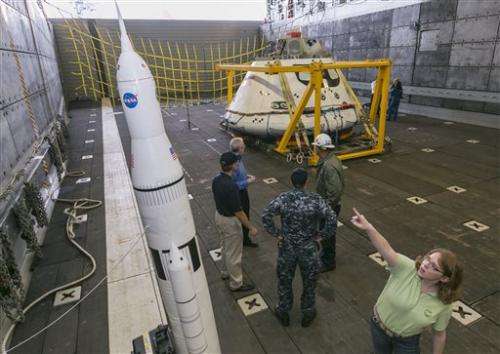US Navy practices retrieving Orion spacecraft

The U.S. Navy and NASA completed the second round of practice recoveries of the Orion spacecraft, which is designed to bring humans to the moon, asteroids and, eventually, to Mars.
The tests took place off the coast of Baja California, Mexico, where the Orion will splash down Dec. 4 after reaching an altitude of 3,600 miles (5,790 kilometers).
The December mission will be crew-less, as will a scheduled 2017 orbit around the moon. But it's all part of a long-term effort to bring humans further into space than they've ever traveled.
"We're building a crewed vehicle to go to other planets," said Larry Price, Lockheed Martin's deputy program manager for the Orion. Lockheed Martin designed and built the Orion for NASA. "(The Orion) is the complex vehicle that will be able to return them safely," Price said.
Traveling to and from earth, the Orion will face up to 4,000 degrees Fahrenheit (2,204 degrees Celsius) heat and move at speeds of up to 20,000 mph.
Parachutes, a protective heat shield and thrusters will slow down the Orion and help it land accurately in the sea, NASA Orion program manager Mark Geyer said.
In the 1960s and 1970s, when dropping into the sea was the landing method of choice for the Apollo and Gemini spacecraft, the Navy used helicopters to locate newly arrived astronauts.

But in this next chapter of sea recoveries, which haven't been carried out since 1975, the spacecraft is towed up a ramp into the stern of a naval vessel.
© 2014 The Associated Press. All rights reserved.





















